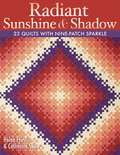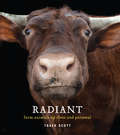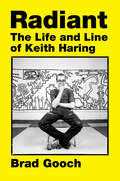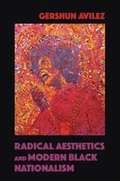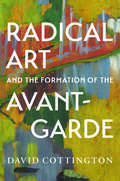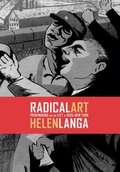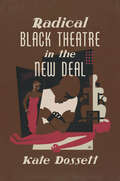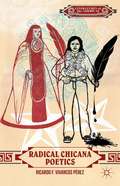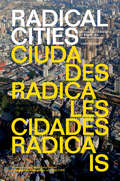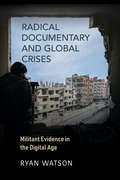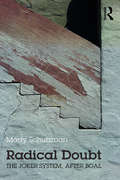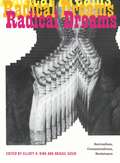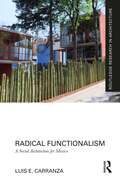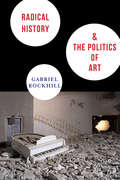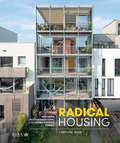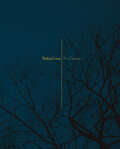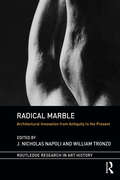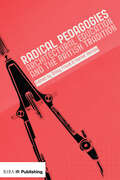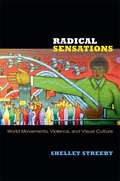- Table View
- List View
Radiant Sunshine & Shadow: 23 Quilts with Nine-Patch Sparkle
by Helen Frost Catherine SkowTurn an Old Amish Favorite into Shimmering New Quilts • Make 23 shimmering Sunshine & Shadow quilts from just one easy block • 13 complete projects, plus 10 gallery quilts with detailed materials lists, cutting charts, and sewing charts • Quick strip-piecing methods and simple Nine-Patch blocks make these intricate-looking projects easy for everyone-beginners, too! • Sizes include wall and lap quilts, plus bed quilts in sizes from crib to king • The authors guide you step by step through cutting, piecing, assembling, and finishing your quilt-everything you need for perfect results You'll be surprised by how easy it is to make these dramatic quilts based on the traditional Sunshine & Shadow design. Learn to create shimmering effects with subtle blends of light and dark fabrics, then accent your creations with appliqué and fabulous borders. *Important Note about PRINT ON DEMAND Editions: This title will be printed after purchase and will arrive separately from any in-stock items. Please allow approximately 2 weeks for USA delivery, with an additional 2 weeks for international shipments. Expedited shipping is not available on POD Editions. The printing quality in this copy will vary from the original offset printing edition and may look more saturated due to printing on demand by a high-quality printer on uncoated (non-glossy) paper. The information presented in this version is the same as the most recent printed edition. Any pattern pullouts have been separated and presented as single pages.
Radiant: Farm Animals Up Close and Personal
by Traer ScottGregarious or shy, curious or placid, playful or retiring, all the animals in Traer Scott's newest collection have one thing in common: a sparkling personality! This whimsical, soulful, and personal photo collection focuses on the lives of the farm animals we often take for granted. Scott introduces us to barnyard animals both familiar and lesser known, from cows, pigs, sheep, and chickens to Dolly the wooly llama, Bianca the Sicilian miniature donkey, Percy the Indian peafowl, and Justice the yak. Some of the animals are kept as pets; others are denizens of farm sanctuaries that Scott has visited. She shares her anecdotes about a Texas longhorn steer whose best friends are a trio of goats, a turkey who likes to snack on grapes and watermelon, and many others. Lively captions provide information on each breed, to round out this enchanting tribute to our four-legged (and winged) friends from the farm.
Radiant: The Life and Line of Keith Haring
by Brad Gooch“It’s all here: the grade school Walt Disney and Dr. Seuss; the adolescent acid trips; the fondness for Post-it notes and flying saucers; the long tails of Dubuffet and Burroughs; the encounters with Madonna, Warhol, and one game-changer of a subway Johnny Walker Red poster. Brad Gooch takes us deep into Keith Haring’s imagination while somehow managing to fix the aura and energy of the 1980s New York art scene to the page. A keen-eyed, beautifully written biography, atmospheric, exuberant, and as radiant as they come.”—Stacy Schiff, Pulitzer Prize winning author of The Revolutionary: Sam AdamsA stunning life of the iconic American artist, Keith Haring, by the acclaimed biographer Brad Gooch.In the 1980s, the subways of New York City were covered with art. In the stations, black matte sheets were pasted over outdated ads, and unsigned chalk drawings often popped up on these blank spaces. These temporary chalk drawings numbered in the thousands and became synonymous with a city as diverse as it was at war with itself, beset with poverty and crime but alive with art and creative energy. And every single one of these drawings was done by Keith Haring.Keith Haring was one of the most emblematic artists of the 1980s, a figure described by his contemporaries as “a prophet in his life, his person, and his work.” Part of an iconic cultural crowd that included Andy Warhol, Madonna, and Basquiat, Haring broke down the barriers between high art and popular culture, creating work that was accessible for all and using it as a means to provoke and inspire radical social change. Haring died of AIDS in 1990. To this day, his influence on our culture remains incontrovertible, and his glamorous, tragically short life has a unique aura of mystery and power.Brad Gooch, noted biographer of Flannery O’Connor and Frank O’Hara, was granted access to Haring’s extensive archive. He has written a biography that will become the authoritative work on the artist. Based on interviews with those who knew Haring best and drawing from the rich archival history, Brad Gooch sets out to capture the magic of Keith Haring: a visionary and timeless icon.
Radical Aesthetics and Modern Black Nationalism (The New Black Studies Series)
by GerShun AvilezRadical Aesthetics and Modern Black Nationalism explores the long-overlooked links between black nationalist activism and the renaissance of artistic experimentation emerging from recent African American literature, visual art, and film. GerShun Avilez charts a new genealogy of contemporary African American artistic production that illuminates how questions of gender and sexuality guided artistic experimentation in the Black Arts Movement from the mid-1960s to the mid-1970s. As Avilez shows, the artistic production of the Black Arts era provides a set of critical methodologies and paradigms rooted in the disidentification with black nationalist discourses. Avilez's close readings study how this emerging subjectivity, termed aesthetic radicalism , critiqued nationalist rhetoric in the past. It also continues to offer novel means for expressing black intimacy and embodiment via experimental works of art and innovative artistic methods. A bold addition to an advancing field, Radical Aesthetics and Modern Black Nationalism rewrites recent black cultural production even as it uncovers unexpected ways of locating black radicalism.
Radical Art and the Formation of the Avant-Garde
by David CottingtonAn authoritative re-definition of the social, cultural and visual history of the emergence of the &“avant-garde&” in Paris and London Over the past fifty years, the term "avant-garde" has come to shape discussions of European culture and modernity, ubiquitously taken for granted but rarely defined. This ground-breaking book develops an original and searching methodology that fundamentally reconfigures the social, cultural, and visual context of the emergence of the artistic avant-garde in Paris and London before 1915, bringing the material history of its formation into clearer and more detailed focus than ever before. Drawing on a wealth of disciplinary evidence, from socio-economics to histories of sexuality, bohemia, consumerism, politics, and popular culture, David Cottington explores the different models of cultural collectivity in, and presumed hierarchies between, these two focal cities, while identifying points of ideological influence and difference between them. He reveals the avant-garde to be at once complicit with, resistant to, and a product of the modernizing forces of professionalization, challenging the conventional wisdom on this moment of cultural formation and offering the means to reset the terms of avant-garde studies.
Radical Art: Printmaking and the Left in 1930s New York
by Helen LangaHelen Langa shows how innovative printmakers developed "social viewpoint" works that focused on contemporary issues of labor justice, anti-racism, and anti-fascist activism.
Radical Black Theatre in the New Deal (The John Hope Franklin Series in African American History and Culture)
by Kate DossettBetween 1935 and 1939, the United States government paid out-of-work artists to write, act, and stage theatre as part of the Federal Theatre Project (FTP), a New Deal job relief program. In segregated "Negro Units" set up under the FTP, African American artists took on theatre work usually reserved for whites, staged black versions of "white" classics, and developed radical new dramas. In this fresh history of the FTP Negro Units, Kate Dossett examines what she calls the black performance community—a broad network of actors, dramatists, audiences, critics, and community activists—who made and remade black theatre manuscripts for the Negro Units and other theatre companies from New York to Seattle. Tracing how African American playwrights and troupes developed these manuscripts and how they were then contested, revised, and reinterpreted, Dossett argues that these texts constitute an archive of black agency, and understanding their history allows us to consider black dramas on their own terms. The cultural and intellectual labor of black theatre artists was at the heart of radical politics in 1930s America, and their work became an important battleground in a turbulent decade.
Radical Chicana Poetics (Literatures of the Americas)
by Ricardo F. Vivancos PérezIn This Bridge Called My Back, Gloria Anzaldúa wrote: "A woman who writes has power. A woman who writes is feared. In the eyes of the world this makes us dangerous beasts." Her statement marked a moment of collective self-recognition. Radical Chicana Poetics considers this moment as a point of entry into Chicana writings. By offering a comparative analysis of works by Anzaldúa, Cherríe Moraga, Ana Castillo, Emma Pérez, Alicia Gaspar de Alba, and Sandra Cisneros, this book elucidates the subtle differences among them in relation to contemporary cultural production and feminist activism. Additionally, this book addresses questions of positionality and ethics for the Chicana studies scholar.
Radical Cities
by Justin McguirkWhat makes the city of the future? How do you heal a divided city? In RADICAL CITIES, Justin McGuirk travels across Latin America in search of the activist architects, maverick politicians and alternative communities already answering these questions. From Brazil to Venezuela, and from Mexico to Argentina, McGuirk discovers the people and ideas shaping the way cities are evolving. Ever since the mid twentieth century, when the dream of modernist utopia went to Latin America to die, the continent has been a testing ground for exciting new conceptions of the city. An architect in Chile has designed a form of social housing where only half of the house is built, allowing the owners to adapt the rest; Medillín, formerly the world's murder capital, has been transformed with innovative public architecture; squatters in Caracas have taken over the forty-five-storey Torre David skyscraper; and Rio is on a mission to incorporate its favelas into the rest of the city. Here, in the most urbanised continent on the planet, extreme cities have bred extreme conditions, from vast housing estates to sprawling slums. But after decades of social and political failure, a new generation has revitalised architecture and urban design in order to address persistent poverty and inequality. Together, these activists, pragmatists and social idealists are performing bold experiments that the rest of the world may learn from.From the Hardcover edition.
Radical Documentary and Global Crises: Militant Evidence in the Digital Age
by Ryan WatsonWhen independent filmmakers, activists, and amateurs document the struggle for rights, representation, and revolution, they instrumentalize images by advocating for a particular outcome. Ryan Watson calls this "militant evidence."In Radical Documentary and Global Crises, Watson centers the discussion on extreme conflict, such as the Iraq War, the occupation of Palestine, the war in Syria, mass incarceration in the United States, and child soldier conscription in the Congo. Under these conditions, artists and activists aspire to document, archive, witness, and testify. The result is a set of practices that turn documentary media toward a commitment to feature and privilege the media made by the people living through the terror. This footage is then combined with new digitally archived images, stories, and testimonials to impact specific social and political situations. Radical Documentary and Global Crises re-orients definitions of what a documentary is, how it functions, how it circulates, and how its effect is measured, arguing that militant evidence has the power to expose, to amass, and to adjudicate.
Radical Doubt: The Joker System, after Boal
by Mady SchutzmanRadical Doubt investigates ethical play across a spectrum of performances, on and off the stage. In witty, recursive, personal, and propulsive prose, Mady Schutzman elaborates on the Joker System, conceived by Augusto Boal, best known for Theatre of the Oppressed. The Joker System is a collaborative approach to representing social dilemmas through a rare fusion of destabilizing ambiguity and journalistic rigor. Schutzman models the Joker System while expanding well beyond the theatrical. In polyphonic compositions that perform their own philosophy, she uncovers illuminating links between calculus and conjuring, kōans and resistance, humor and witnessing, complexity theory and sorely needed new practices of living in our divisive times. These life practices rely upon crafty and circuitous strategies to deliver their subversive punch. Jok(er)ing matters, Schutzman insists. When communities fragment and identities fixate, enter the trickster! Sonja KuftinecTheatre Arts and Dance, University of Minnesota
Radical Dreams: Surrealism, Counterculture, Resistance (Refiguring Modernism #35)
by Elliott H. King and Abigail SusikSurrealism is widely thought of as an artistic movement that flourished in Europe between the two world wars. However, during the 1960s, ’70s, and ’80s, diverse radical affinity groups, underground subcultures, and student protest movements proclaimed their connections to surrealism. Radical Dreams argues that surrealism was more than an avant-garde art movement; it was a living current of anti-authoritarian resistance.Featuring perspectives from scholars across the humanities and, distinctively, from contemporary surrealist practitioners, this volume examines surrealism’s role in postwar oppositional cultures. It demonstrates how surrealism’s committed engagement extends beyond the parameters of an artistic style or historical period, with chapters devoted to Afrosurrealism, Ted Joans, punk, the Situationist International, the student protests of May ’68, and other topics. Privileging interdisciplinary, transhistorical, and material culture approaches, contributors address surrealism’s interaction with New Left politics, protest movements, the sexual revolution, psychedelia, and other subcultural trends around the globe. A revelatory work, Radical Dreams definitively shows that the surrealist movement was synonymous with cultural and political radicalism. It will be especially valuable to those interested in the avant-garde, contemporary art, and radical social movements.In addition to the editors, the contributors to this volume include Mikkel Bolt Rasmussen, Jonathan P. Eburne, David Hopkins, Claire Howard, Michael Löwy, Alyce Mahon, Gavin Parkinson, Grégory Pierrot, Penelope Rosemont, Ron Sakolsky, Marie Arleth Skov, Ryan Standfest, and Sandra Zalman.
Radical Dreams: Surrealism, Counterculture, Resistance (Refiguring Modernism)
by Elliott H. King and Abigail SusikSurrealism is widely thought of as an artistic movement that flourished in Europe between the two world wars. However, during the 1960s, ’70s, and ’80s, diverse radical affinity groups, underground subcultures, and student protest movements proclaimed their connections to surrealism. Radical Dreams argues that surrealism was more than an avant-garde art movement; it was a living current of anti-authoritarian resistance.Featuring perspectives from scholars across the humanities and, distinctively, from contemporary surrealist practitioners, this volume examines surrealism’s role in postwar oppositional cultures. It demonstrates how surrealism’s committed engagement extends beyond the parameters of an artistic style or historical period, with chapters devoted to Afrosurrealism, Ted Joans, punk, the Situationist International, the student protests of May ’68, and other topics. Privileging interdisciplinary, transhistorical, and material culture approaches, contributors address surrealism’s interaction with New Left politics, protest movements, the sexual revolution, psychedelia, and other subcultural trends around the globe. A revelatory work, Radical Dreams definitively shows that the surrealist movement was synonymous with cultural and political radicalism. It will be especially valuable to those interested in the avant-garde, contemporary art, and radical social movements.In addition to the editors, the contributors to this volume include Mikkel Bolt Rasmussen, Jonathan P. Eburne, David Hopkins, Claire Howard, Michael Löwy, Alyce Mahon, Gavin Parkinson, Grégory Pierrot, Penelope Rosemont, Ron Sakolsky, Marie Arleth Skov, Ryan Standfest, and Sandra Zalman.
Radical Functionalism: A Social Architecture for Mexico (Routledge Research in Architecture)
by Luis E. CarranzaRadical Functionalism: A Social Architecture for Mexico provides a complex and nuanced understanding of the functionalist architecture developed in Mexico during the 1930s. It carefully re-reads the central texts and projects of its main advocates to show how their theories responded to the socially and culturally charged Mexican context. These, such as architects Juan Legarreta, Juan O’Gorman, the Union of Socialist Architects, and Manuel Amábilis, were part of broader explorations to develop a modern, national architecture intended to address the needs of the Mexican working classes. Through their refunctioning of functionalism, these radical thinkers showed how architecture could stand at the precipice of Mexico's impending modernization and respond to its impending changes. The book examines their engagement and negotiation with foreign influences, issues of gender and class, and the separation between art and architecture. Functionalist practices are presented as contradictory and experimental, as challenging the role of architecture in the transformation of society, and as intimately linked to art and local culture in the development of new forms of architecture for Mexico, including the "vernacularization" of functionalism itself. Uniquely including translations of two manifesto-like texts by O’Gorman expressing the polemical nature of their investigations, Radical Functionalism: A Social Architecture for Mexico will be a useful reference for scholars, researchers and students interested in the history of architectural movements.
Radical Gestures
by Jayne WarkWark brings together a wide range of artists, including Lisa Steele, Martha Rosler, Lynda Benglis, Gillian Collyer, Margaret Dragu, and Sylvie Tourangeau, and provides detailed readings and viewings of individual pieces, many of which have not been studied in detail before. She reassesses assumptions about the generational and thematic characteristics of feminist art, placing feminist performance within the wider context of minimalism, conceptualism, land art, and happenings
Radical Gestures: Feminism and Performance Art in North America
by Jayne WarkWark brings together a wide range of artists, including Lisa Steele, Martha Rosler, Lynda Benglis, Gillian Collyer, Margaret Dragu, and Sylvie Tourangeau, and provides detailed readings and viewings of individual pieces, many of which have not been studied in detail before. She reassesses assumptions about the generational and thematic characteristics of feminist art, placing feminist performance within the wider context of minimalism, conceptualism, land art, and happenings
Radical History and the Politics of Art
by Gabriel RockhillGabriel Rockhill opens new space for rethinking the relationship between art and politics. Rather than understanding the two spheres as separated by an insurmountable divide or linked by a privileged bridge, Rockhill demonstrates that art and politics are not fixed entities with a singular relation but rather dynamically negotiated, sociohistorical practices with shifting and imprecise borders. Radical History and the Politics of Art proposes a significant departure from extant debates on what is commonly called "art" and "politics," and the result is an impressive foray into the force field of history, in which cultural practices are meticulously analyzed in their social and temporal dynamism without assuming a conceptual unity behind them. Rockhill therefore develops an alternative logic of history and historical change, as well as a novel account of social practices and a multidimensional theory of agency. Engaging with a diverse array of intellectual, artistic, and political constellations, this tour de force diligently maps the various interactions between different dimensions of aesthetic and political practices as they intertwine and sometimes merge in precise fields of struggle.
Radical History and the Politics of Art (New Directions in Critical Theory #29)
by Gabriel RockhillGabriel Rockhill opens new space for rethinking the relationship between art and politics. Rather than understanding the two spheres as separated by an insurmountable divide or linked by a privileged bridge, Rockhill demonstrates that art and politics are not fixed entities with a singular relation but rather dynamically negotiated, sociohistorical practices with shifting and imprecise borders. Radical History and the Politics of Art proposes a significant departure from extant debates on what is commonly called "art" and "politics," and the result is an impressive foray into the force field of history, in which cultural practices are meticulously analyzed in their social and temporal dynamism without assuming a conceptual unity behind them. Rockhill thereby develops an alternative logic of history and historical change, as well as a novel account of social practices and a multidimensional theory of agency. Engaging with a diverse array of intellectual, artistic, and political constellations, this tour de force diligently maps the various interactions between different dimensions of aesthetic and political practices as they intertwine and sometimes merge in precise fields of struggle.
Radical Housing: Designing multi-generational and co-living housing for all
by Caroline DoveRadical Housing explores the planning, technical, financial, health-based and social background for developing multi-generational homes and co-living. Abundantly illustrated with case studies and plans from projects across the UK and abroad, this book inform sand inspires the delivery of alternative approaches to affordable and flexible housing, and is an essential text for architecture practitioners, students, and community groups.
Radical Love
by Toni GreavesA photojournalist documents a young woman’s journey as joins a New Jersey convent to become a nun.The sudden revelation of a powerful religious calling was an entirely unexpected event in the life of a college student named Lauren. But when it became clear to her that she had a spiritual vocation, she made the exceptional decision to dedicate her life to God. Drawing upon many visits to the cloistered religious community of Dominican nuns in Summit, New Jersey, photographer Toni Greaves has created a luminous body of work that follows the transformative journey by which Lauren became Sister Maria Teresa of the Sacred Heart. These meditative photographs capture the radical joy of a life dedicated unequivocally to love.“Toni Greaves’s luminous images marry the quotidian with the divine in all sorts of ways: a young novice dribbles a basketball in full habit; a jar of Vick’s VapoRub nestles a bottle of holy water; a group portrait of all 19 sisters, whose ages range from 25 to 90, includes Sabina, the golden retriever, splayed flat on the floor.” —New York Times
Radical Marble: Architectural Innovation from Antiquity to the Present (Routledge Research in Art History)
by J. Nicholas Napoli William TronzoMarble is one of the great veins through the architectural tradition and fundamental building block of the Mediterranean world, from the Parthenon of mid-fifth century Athens, which was constructed of pentelic marble, to Justinian’s Hagia Sophia in Constantinople and the Renaissance and Baroque basilica of St. Peter’s in the Vatican. Scholarship has done much in recent years to reveal the ways and means of marble. The use of colored marbles in Roman imperial architecture has recently been the subject of a major exhibition and the medieval traditions of marble working have been studied in the context of family genealogies and social networks. In addition, architectural historians have revealed the meanings evoked by marble revetted and paved surfaces, from Heavenly Jerusalem to frozen water. The present volume builds upon the body of recent and emerging research - from antiquity to the present day - to embrace a global focus and address the more unusual (or at least unexpected) uses, meanings, and aesthetic appeal of marble. It presents instances where the use of marble has revolutionized architectural practice, suggested new meaning for the built environment, or defined a new aesthetic - moments where this well-known material has been put to radical use.
Radical Pedagogies: Architectural Education and the British Tradition
by Froud Daisy Harriss HarrietThe anticipated reduction in the duration of architecture education in the UK and across Europe has encouraged a sense of collective openness towards exploring other models of professional education delivery. There’s never been a better time to be thoughtfully innovative and take the initiative.This book provides a much needed debate about the future of architectural education, placing it within its unique historic tradition and raising fundamental questions such as who should be teaching architecture? Where should they be situated and should it be viewed as an interdisciplinary, rather than silo-based subject?Featuring voices as varied as digital strategists, students and client managers, Radical Pedagogies consolidates academic and well as practice-based evidence into a set of actionable insights, aimed at empowering schools, educators, and students alike.
Radical Sensations: World Movements, Violence, and Visual Culture
by Shelley StreebyThe significant anarchist, black, and socialist world-movements that emerged in the late nineteenth century and early twentieth adapted discourses of sentiment and sensation and used the era's new forms of visual culture to move people to participate in projects of social, political, and economic transformation. Drawing attention to the vast archive of images and texts created by radicals prior to the 1930s, Shelley Streeby analyzes representations of violence and of abuses of state power in response to the Haymarket police riot, of the trial and execution of the Chicago anarchists, and of the mistreatment and imprisonment of Ricardo and Enrique Flores Magón and other members of the Partido Liberal Mexicano. She considers radicals' reactions to and depictions of U. S. imperialism, state violence against the Yaqui Indians in the U. S. -Mexico borderlands, the failure of the United States to enact laws against lynching, and the harsh repression of radicals that accelerated after the United States entered the First World War. By focusing on the adaptation and critique of sentiment, sensation, and visual culture by radical world-movements in the period between the Haymarket riots of 1886 and the deportation of Marcus Garvey in 1927, Streeby sheds new light on the ways that these movements reached across national boundaries, criticized state power, and envisioned alternative worlds.
Radical Sensing and Performer Training: Elsa Gindler’s Embodied Translations (Perspectives on Performer Training)
by Rebecca LoukesThis exciting new book explores the pioneering radical sensing work of Elsa Gindler (1885–1961) and the practices of five women inspired by her. It re-considers a range of trajectories of influence across the established canons of twentieth-century performer training practices and challenges conventions of performer training historiography. Moving from the early twentieth‑century Physical Culture movement through Modern and Postmodern dance training in Europe and North America to contemporary devised theatre in the UK, this is the first book‑length study of Gindler’s pedagogy in relation to performance. It allows trainers, arts practitioners, theatre, dance and art historians, and students to understand previously untold stories in performance, Somatics and philosophies of knowledge. Bringing Gindler’s unique practice into dialogue with philosophies drawn from pragmatism and phenomenology, the book explores concepts of concentration and Gelassenheit, situation, gestalts of breathing, negative epistemology and phronesis, to create a picture of Elsa Gindler’s work as situated, context specific and inter‑subjective. It also explores how feminist ways of knowing and being are embedded in the practices themselves.Drawing on the author’s 30 years of experience of training in work inspired by Elsa Gindler, this book allows theories and practices to converse and merge to build a rich and multi‑dimensional perspective of performer training. Woven throughout are practical experiments for the reader to try, alongside analyses of performances and previously unpublished workshop material and notes. Beyond performance, this book locates Gindler’s work within wider contexts of social and ecological crises and suggests that this radical sensing practice can be used as a quiet way to make a difference in the world.
Radical Sewing: Pattern-Free, Sustainable Fashions for All Bodies
by Kate WeissRadical Sewing is a guide for learning how to make your own clothes. Kate introduces you to the basics and best practices of garment sewing for yourself at home, as well as advice and info on things you wouldn&’t even know to ask about sewing. Topics include hand sewing, picking out a sewing machine, adding pockets to anything, sewing a button so it stays on, altering your clothes to fit your unique body, and so much more! Regardless of your sewing experience, gender, or body type, this illustrated guide will empower you to make your wardrobe your own. With loads of encouragement to try things out, all you&’ll need to do is experiment and break the rules to create the clothes and outfits that you want to wear.
